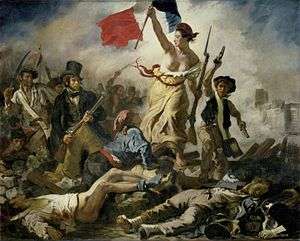Carnation Revolution
| Revolução dos Cravos 25 de Abril | |||
|---|---|---|---|
| Part of Cold War | |||
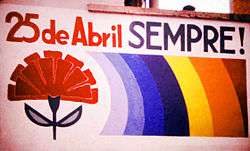 A mural celebrating the revolution: "25th of April Always!" | |||
| Date | 25 April 1974 | ||
| Location | Portugal | ||
| Caused by | |||
| Goals | |||
| Methods | |||
| Resulted in |
| ||
| Parties to the civil conflict | |||
|
| |||
| Lead figures | |||
|
| |||
| Casualties | |||
| 4 killed | |||
Part of a series on the |
|---|
| History of Portugal |
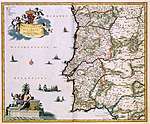 |
| Timeline |
|
|
The Carnation Revolution (Portuguese: Revolução dos Cravos), also referred to as the 25th of April (Portuguese: vinte e cinco de Abril), was initially a military coup in Lisbon, Portugal, on 25 April 1974 which overthrew the authoritarian regime of the Estado Novo.[1] The revolution started as a military coup organised by the Armed Forces Movement (Portuguese: Movimento das Forças Armadas, MFA) composed of military officers who opposed the regime, but the movement was soon coupled with an unanticipated and popular campaign of civil resistance. This movement would lead to the fall of the Estado Novo and the withdrawal of Portugal from its African colonies.
The name "Carnation Revolution" comes from the fact that almost no shots were fired and that when the population took to the streets to celebrate the end of the dictatorship and war in the colonies, carnations were put into the muzzles of rifles and on the uniforms of the army men by Celeste Caeiro.[2] In Portugal, 25 April is a national holiday, known as Freedom Day (Portuguese: Dia da Liberdade), in commemoration of the events of this day.
Overview
Portugal had been run by an authoritarian dictatorship (the Estado Novo, or "New State"), which was considered by many to be fascist, for over four decades.[3] The events of the revolution effectively changed the government into a democracy, and produced enormous social, economic, territorial, demographic, and political changes in the country, after two years of a transitional period known as PREC (Processo Revolucionário Em Curso, or On-Going Revolutionary Process), characterized by social turmoil and power disputes between left- and right-wing political forces.
Despite repeated appeals by the revolutionaries, broadcast over the radio, asking the population to stay home, thousands of Portuguese descended on the streets, mixing with the military insurgents.[4]
The military-led coup returned democracy to Portugal, ending the unpopular Colonial War in which thousands of Portuguese citizens had been conscripted into military service, and replacing the Estado Novo regime and its secret police which repressed elemental civil liberties and political freedoms. It started as a professional class[5] protest of Portuguese Armed Forces captains against a decree law: the Dec Lei nº 353/73 of 1973.[6][7]
A group of Portuguese low-ranking officers organised within the Armed Forces Movement (MFA – Movimento das Forças Armadas), including some who had been fighting the pro-independence guerrillas in the Portuguese empire's territories in Africa,[8] and rose to overthrow the Estado Novo regime that had ruled Portugal since the 1930s. Portugal's new regime pledged itself to end the colonial wars and began negotiations with the African independence movements. By the end of 1974, Portuguese troops had been withdrawn from Portuguese Guinea and the latter had become a UN member state. This was followed by the independence of Cape Verde, Mozambique, São Tomé and Príncipe and Angola in 1975. The Carnation Revolution in Portugal also led to Portugal's withdrawal from East Timor in south-east Asia. These events prompted a mass exodus of Portuguese citizens from Portugal's African territories (mostly from Angola and Mozambique), creating over a million Portuguese refugees — the retornados.[9][10]
Although the regime's political police, PIDE, killed four people before surrendering, the revolution was unusual in that the revolutionaries did not use direct violence to achieve their goals. Holding red carnations (cravos in Portuguese), many people joined revolutionary soldiers on the streets of Lisbon, in apparent joy and audible euphoria.[11] Red is a symbolic colour for socialism and communism, which were the main ideological tendencies of many anti-New State insurgents.[12] It was the end of the Estado Novo, the longest-lived authoritarian regime in Western Europe, and the final dissolution of the Portuguese Empire. In the aftermath of the revolution a new constitution was drafted, censorship was formally prohibited, free speech was declared, political prisoners were released and the Portuguese overseas territories in Sub-Saharan Africa were immediately given their independence. East Timor was also offered independence, shortly before being invaded by Indonesia.
Context
At the beginning of the 1970s, a near-half century of authoritarian rule continued to weigh heavily on Portugal. After the 28 May 1926 coup d'état, Portugal implemented an authoritarian regime of social-Catholic and Integralist inspiration. In 1933, the regime was recast and renamed Estado Novo ("New State"), and António de Oliveira Salazar was named Prime Minister until 1968, when he suffered a stroke following a domestic accident. He was replaced in September by Marcello Caetano, who served until he was deposed on 25 April 1974.
Under the Estado Novo, Portugal's undemocratic government was tolerated by its NATO partners due to its anti-communist stance; this attitude changed dramatically during the mid-1960s, under pressure of public opinion and leftwing movements rising in Europe. There were formal elections but they were rarely contested—with the opposition using the limited political freedoms allowed during the brief election period to openly protest against the regime, withdrawing their candidates before the election so as not to provide the regime with any legitimacy. In 1958, General Humberto Delgado—a former member of the regime—stood against the regime's presidential candidate, Américo Tomás, and refused to allow his name to be withdrawn from the competition.
Tomás won the election, but only amidst claims of widespread electoral fraud; it was widely thought that Delgado would have won had the election been honest. Immediately after this election, Salazar's government abandoned the practice of popularly electing the president, with that task being given thereafter to the regime-loyal National Assembly. During Caetano's time in office, his attempts at minor political reform were obstructed by the important Salazarist elements within the regime (known as the Bunker). The hardliners had critical support from Tomás, who was not willing to give Caetano nearly as free a hand as Salazar had.
The Estado Novo's political police—the PIDE (Polícia Internacional e de Defesa do Estado), later to become DGS (Direcção-Geral de Segurança), and originally the PVDE (Polícia de Vigilância e Defesa do Estado)—persecuted opponents of the regime, who were often tortured, imprisoned or killed.
The international context was not favourable to the Portuguese regime. The Cold War was near its peak, and both Western and Eastern-bloc states were supporting the guerrillas in the Portuguese colonies, attempting to bring these under, respectively, American and Soviet influence (see Portuguese Colonial War). The overseas policy of the Portuguese Government and the desire of many colonial residents to remain under Portuguese rule would lead to an abrupt decolonisation, which occurred only after the Carnation Revolution of April 1974 and the fall of the regime. For the Portuguese ruling regime, the overseas empire was a matter of national interest.
In the view of many Portuguese, a colonial empire was necessary for continued national power and influence. Despite objections in world forums such as the United Nations, Portugal had long maintained that its African colonies were an integral part of Portugal, and felt obliged to militarily defend them against Communist-inspired armed groups, particularly after India's annexation of Portuguese exclaves Goa, Daman and Diu (Portuguese India), in 1961 (see Indian Invasion of Goa).
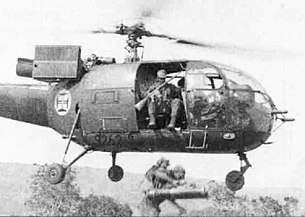
Independence movements in Portugal's African possessions
Independence movements started operations in the African colonies of Portuguese Mozambique, Portuguese Congo, Portuguese Angola, and Portuguese Guinea. The various conflicts forced the Salazar and Caetano regimes to spend more of the country's budget on colonial administration and military expenditures, and Portugal soon found itself increasingly isolated from the rest of the world. Throughout the war period Portugal faced increasing dissent, arms embargoes and other punitive sanctions imposed by most of the international community.[13]
For Portuguese society the war was becoming even more unpopular due to its length and financial costs, the worsening of diplomatic relations with other United Nations members, and the role it had always played as a factor of perpetuation of the Estado Novo regime. It was this escalation that would lead directly to the mutiny of members of the FAP in the Carnation Revolution in 1974 – an event that would lead to the independence of the former Portuguese colonies in Africa. Atrocities, such as that at Wiriyamu in Mozambique, undermined the war's popularity and the government's diplomatic position – although some details of the Wiriyamu case remain disputed.[13][14][15][16][17][18][19]
After Caetano succeeded to the presidency, colonial war became a major cause of dissent and a focus for anti-government forces in Portuguese society. Many left-wing students and anti-war activists were forced to leave the country so they could escape conscription, imprisonment and torture by government forces. However, between 1945 and 1974, there were also three generations of militants of the radical right at the Portuguese universities and schools, guided by a revolutionary nationalism partly influenced by the political sub-culture of European neofascism. The core of these radical students' struggle lay in an uncompromising defense of the Portuguese Empire in the days of the authoritarian regime.[20]
Economic conditions
The economy of Portugal and its colonies on the eve of the Carnation Revolution was growing well above the European average. Average family purchasing power was rising together with new consumption patterns and trends and this was promoting both investment in new capital equipment and consumption expenditure for durable and nondurable consumer goods. The Estado Novo regime economic policy encouraged and created conditions for the formation of large business conglomerates. The regime maintained a policy of corporatism that resulted in the placement of a big part of the Portuguese economy in the hands of a number of strong conglomerates, including those founded by the families of António Champalimaud (Banco Totta & Açores, Banco Pinto & Sotto Mayor, Secil, Cimpor), José Manuel de Mello (CUF – Companhia União Fabril), Américo Amorim (Corticeira Amorim) and the dos Santos family (Jerónimo Martins).
Those Portuguese conglomerates had a business model with similarities to South Korean chaebols and Japanese keiretsus and zaibatsus. The Companhia União Fabril (CUF) was one of the largest and most diversified Portuguese conglomerates with its core businesses (cement, chemicals, petrochemicals, agrochemicals, textiles, beer, beverages, metallurgy, naval engineering, electrical engineering, insurance, banking, paper, tourism, mining, etc.) and corporate headquarters located in mainland Portugal, but also with branches, plants and several developing business projects all around the Portuguese Empire, especially in the Portuguese territories of Cabinda, Angola and Mozambique.
Other medium-sized family companies specialized in textiles (for instance those located in the city of Covilhã and the northwest), ceramics, porcelain, glass and crystal (like those of Alcobaça, Caldas da Rainha and Marinha Grande), engineered wood (like SONAE near Porto), canned fish (like those of Algarve and the northwest), fishing, food and beverages (alcoholic beverages, from liqueurs like Licor Beirão and Ginjinha, to beer like Sagres, were produced across the entire country, but Port Wine was one of its most reputed and exported alcoholic beverages), tourism (well established in Estoril/Cascais/Sintra and growing as an international attraction in the Algarve since the 1960s) and in agriculture (like the ones scattered around the Alentejo – known as the breadbasket of Portugal) completed the panorama of the national economy by the early 1970s. In addition, rural areas' populations were committed to agrarianism that was of great importance for a majority of the total population, with many families living exclusively from agriculture or complementing their salaries with farming, husbandry and forestry yields.
Besides that, the colonies were also displaying impressive economic growth and development rates from the 1920s onwards. Even during the Portuguese Colonial War (1961–1974), a counterinsurgency war against independentist guerrilla and terrorism, Portuguese Congo, Portuguese Angola and Portuguese Mozambique (colonies at the time) had continuous economic growth rates and several sectors of its local economies were booming. They were internationally notable centres of production of oil, coffee, cotton, cashew, coconut, timber, minerals (like diamonds), metals (like iron and aluminium), banana, citrus, tea, sisal, beer (Cuca and Laurentina were successful beer brands produced locally), cement, fish and other sea products, beef and textiles. Tourism was also a fast developing activity in Portuguese Africa both by the growing development of and demand for beach resorts and wildlife reserves.
Labour unions were not allowed and a minimum wage policy was not enforced. However, in a context of an expanding economy, bringing better living conditions for the Portuguese population in the 1960s, the outbreak of the colonial wars in Africa set off significant social changes, among them the rapid incorporation of more and more women into the labour market. Marcelo Caetano moved on to foster economic growth and some social improvements, such as the awarding of a monthly pension to rural workers who had never had the chance to pay social security. The objectives of Caetano's pension reform were threefold: enhancing equity, reducing fiscal and actuarial imbalance, and achieving more efficiency for the economy as a whole, for example, by establishing contributions which distorted labour markets less, or by allowing the savings generated by pension funds to increase the investments in the economy.
After Salazar's stroke in 1968, Caetano had taken over the office of Prime Minister. His main slogan was "evolution in continuity", suggesting that there would be a reform of the Salazarist system. His so-called "political spring" (also called Marcelist Spring – Primavera Marcelista) included greater political tolerance and freedom of the press and was regarded as an opportunity by the opposition to gain concessions from the regime. In 1969, the Estado Novo-controlled nation got indeed a very slight taste of democracy and Caetano allowed the establishment of the first democratic labour union movement since the 1920s. Nevertheless, after the elections of 1969 and 1973 it was clear that the past practices of political repression would continue against communists, anti-colonialists and other oppositionists. In 1973, Caetano was pressured by the ultra-right faction inside the Salazarist élite to abandon his reform experiment.
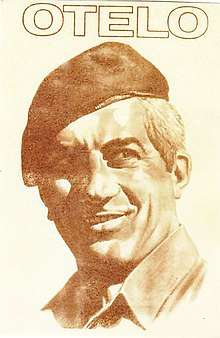
By the early 1970s, the Portuguese Colonial War continued to rage on, requiring a steadily increasing budget. The Portuguese military was overstretched and there was no political solution or end in sight. While the human losses were relatively small, the war as whole had already entered its second decade. The Portuguese ruling regime of Estado Novo faced criticism from the international community and was becoming increasingly isolated.
The colonial war had a profound impact on Portugal—thousands of young men avoided conscription by emigrating illegally, mainly to France and the US. In addition, the other revolutionary Armed Forces Movement (MFA)'s goals were not in the strict interest of the people of Portugal or its colonies, since the movement was initiated not only as an attempt to liberate Portugal from the authoritarian Estado Novo regime, but as an attempt of rebellion against the new Military Laws that were to be presented next year.[21][22]
The Revolution and the whole movement were also a way to work against Laws that would reduce military costs and would reformulate the whole Portuguese Military Branch (Decree Law: Decretos-Leis n.os 353, de 13 de Julho de 1973, e 409, de 20 de Agosto). Younger military academy graduates resented a program introduced by Marcello Caetano whereby militia officers who completed a brief training program and had served in the colonies' defensive campaigns, could be commissioned at the same rank as military academy graduates. As the war in the colonies was becoming increasingly unpopular in Portugal itself with the people becoming weary of war and balking at its ever-rising expense, the military insurgents took advantage of it and got some momentum.
Many ethnic Portuguese of the African colonies were also increasingly willing to accept independence if their economic status could be preserved. Following the coup d'état in Portugal in 1974, the new left-wing revolutionary government of Portugal began to negotiate with the African pro-independence guerrillas. The new government in Lisbon was disinclined to prop up Portugal's convulsing and by now very expensive empire. All the Portuguese territories in Africa were rapidly granted their independence.
Events
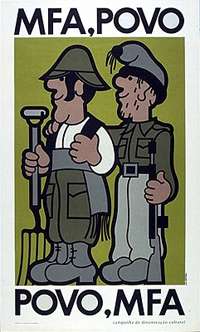
In February 1974, Caetano decided to remove General António de Spínola in the face of increasing dissent by Spinola over the promotion of military officers and the direction of Portuguese colonial policy. This occurred shortly after the publication of Spínolas's book Portugal and the Future, which expressed his political and military views on the Portuguese Colonial War. At this point, several left-wing military officers who opposed the war formed a group of conspirators, the Movimento das Forças Armadas (MFA, "Armed Forces Movement"), to overthrow the government by a military coup. The MFA was headed by major Vitor Alves, major Otelo Saraiva de Carvalho, and captain Vasco Lourenço, later joined by Salgueiro Maia. The movement was significantly aided by other officers in the Portuguese army who supported Spinola and democratic civil and military reform. Some observers speculate that it was Costa Gomes who actually led the revolution.
There were two secret signals of the military coup: first the airing (at 10:55 pm) of the song "E Depois do Adeus" by Paulo de Carvalho (Portugal's entry in the 6 April 1974 Eurovision Song Contest) through the Emissores Associados de Lisboa, which alerted the rebel captains and soldiers to begin the coup. The second signal came on 25 April 1974 at 12:20 am, with Rádio Renascença broadcasting "Grândola, Vila Morena", a song by Zeca Afonso, an influential folk and political musician-singer banned from Portuguese radio at the time. The MFA gave these signals to take over strategic points of power in the country and "announced" that the revolution had started and nothing would stop it except "the possibility of a regime's repression".
Six hours later, the Caetano regime relented. Despite repeated appeals from the "captains of April" (of the MFA) on the radio warning the population to stay safe inside their homes, thousands of Portuguese took to the streets, mingling with the military insurgents and supporting them. One of the central points of those gathering was the Lisbon flower market, then richly stocked with carnations, which were in season. Some military insurgents would put these flowers in their gun-barrels, an image which was shown on television around the world[23]. This would be the origin of the name of this "Carnation Revolution". Although there were no mass demonstrations by the general population prior to the coup, spontaneous civilian involvement turned the military coup into an event with unexpected popular participation.
Caetano found refuge in the main Lisbon military police station at the Largo do Carmo. This building was surrounded by the MFA, which pressured him to cede power to General Spínola. Both Caetano (the prime minister) and Américo Tomás (the president) fled to Brazil. Caetano spent the rest of his life in Brazil, while Tomás returned to Portugal a few years later.
The revolution was closely watched from neighbouring Spain, where the government and opposition were planning for the succession of Francisco Franco, who died a year and a half later, in 1975.
Aftermath
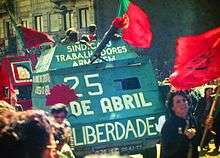
After the military coup in Lisbon on 25 April 1974, power was taken by a military junta, the National Salvation Junta, and Portugal went through a turbulent period, commonly called the Continuing Revolutionary Process (Portuguese: Processo Revolucionário em Curso, or PREC).
Initially there was a confrontation, at times open, at other times hidden, between the conservative forces around Spinola and the radicals of the MFA. Spinola was forced to appoint key figures in the MFA to senior security positions and as a result an attempted coup to halt the progress of democratisation failed and Spinola was removed from office. Then there followed a confrontation within the MFA, which itself splintered, between the most leftist forces, often close to the Communist party, and the more moderate groupings, often close to the Socialists.
This phase of the PREC lasted until 25 November 1975, the day of a pro-communist coup followed by a successful counter-coup by pro-democracy moderates, marked by constant friction between liberal-democratic forces and leftist/communist political parties.[24] After a year, the first free election was carried out on 25 April 1975 in order to write a new Constitution that would replace the Constitution of 1933 which prevailed during the Estado Novo period. In 1976, another election was held and the first Constitutional government, led by the centre-left socialist Mário Soares, assumed office.
Decolonisation
Before April 1974, the war in Africa was consuming as much as 40% of the Portuguese budget and there was no end in sight. At a military level, a part of Guinea-Bissau was de facto independent since 1973, but the capital and the major towns were still under Portuguese control. In Angola and Mozambique, independence movements were only active in a few remote countryside areas from which the Portuguese Army had retreated, and the economies of these two territories were booming.
A direct consequence of the military coup at Lisbon was the sudden withdrawal of Portuguese administrative and military personnel from Portugal's overseas colonies. Hundreds of thousands of other Portuguese citizens—workers, small business people, and farmers (often with deep roots in the former colonies)—also returned to Portugal as retornados.
Angola would later enter into a decades-long civil war which involved nations like the Soviet Union, Cuba, South Africa, and the United States. Millions of Angolans would die in the aftermath of independence, due either to the violence of the armed conflict or malnutrition and disease. After a short period of stability, Mozambique would also later enter into a devastating civil war that left it as one of the poorest nations in the world. Since the 1990s, its situation has improved after the war ended and multi-party elections were held.
East Timor was invaded by Indonesia and would later be occupied until 1999. There were an estimated 102,800 conflict-related deaths in the period 1974–99 (approximately 18,600 killings and 84,200 'excess' deaths from hunger and illness), the majority of which occurred during the subsequent Indonesian occupation.[25]
After a long period of one-party rule, Guinea-Bissau endured a brief civil war and a difficult transition to civilian rule in 1998.
Cape Verde and São Tomé and Príncipe, on the other hand, were spared civil war during the decolonization period, and by the early 1990s, they have both established multi-party political systems.
Macau remained a Portuguese colony until 1999 when China took control by agreement and went on to pursue a "one country, two systems" policy similar to Hong Kong's.
Economic issues
The Portuguese economy had changed significantly by 1973 prior to the revolution, compared with its position in 1961. Total output (GDP at factor cost) had grown by 120 percent in real terms. The pre-revolutionary period was characterized by robust annual growth rates for GDP (6.9 percent), industrial production (9 percent), private consumption (6.5 percent), and gross fixed capital formation (7.8 percent). The revolutionary period itself was characterized by a slowly growing economy whose only impetus was the entering of the European Economic Zone. It never reached pre-revolutionary period growth rates. On the other hand, despite the progress in the 1960s and early 1970s, Portugal at the time of the Revolution was still an underdeveloped country with poor infrastructure and inefficient agriculture as well as the worst health and education indicators in Europe.[26]
However, researchers agree that pre-revolution Portugal increasingly accomplished notable social and economic achievements.[27] After a long period of economic divergence before 1914, the Portuguese economy recovered slightly until 1950, entering thereafter on a path of strong economic growth leading to some convergence with Western Europe, of which Portugal was and remained until the 1980s the poorest country. Portuguese economic growth in the period 1960–73 under the Estado Novo regime (and even with the effects of an expensive war effort in African territories against independence guerrilla groups), created an opportunity for real integration with the developed economies of Western Europe. Through emigration, trade, tourism and foreign investment, individuals and firms changed their patterns of production and consumption, bringing about a structural transformation. Simultaneously, the increasing complexity of a growing economy raised new technical and organizational challenges, stimulating the formation of modern professional and management teams.[28][29]
On 13 November 1972, a sovereign wealth fund (Fundo do Ultramar – The Overseas Fund) was enacted through the Decree Law Decreto-Lei n.º 448/ /72 and the Ministry of Defense ordinance Portaria 696/72, in order to finance the counterinsurgency effort in the Portuguese colonies.[30] While the counterinsurgency war was won in Angola, it was less than satisfactorily contained in Mozambique and dangerously stalemated in Portuguese Guinea from the Portuguese point of view, so the Portuguese Government had decided to create sustainability policies in order to allow continuous sources of financing for the war effort in the long run. In addition, new Decree Laws (Decree Law: Decretos-Leis n.os 353, de 13 de Julho de 1973, e 409, de 20 de Agosto) were enforced in order to cut down military expenses and increase the number of officers by incorporating militia and military academy officers in the Army branches as equals.[7][21][31][32][33]
In the agricultural sector, the collective farms, set up in Alentejo after the 1974–75 expropriations due to the leftist military coup of 25 April 1974, proved incapable of modernizing, and their efficiency declined. According to government estimates, about 900,000 hectares (2,200,000 acres) of agricultural land were occupied between April 1974 and December 1975 in the name of land reform; about 32% of the occupations were ruled illegal. In January 1976, the government pledged to restore the illegally occupied land to its owners, and in 1977, it promulgated the Land Reform Review Law. Restoration of illegally occupied land began in 1978.[34][35]
In 1960, at the initiation of Salazar's more outward-looking economic policy due to the influence of a new wave of technocrats with background in economics (some of whom trained abroad, including in liberal capitalist graduate schools from the USA and the UK), Portugal's per capita GDP was only 38 percent of the EC-12 average; by the end of the Salazar period, in 1968, it had risen to 48 percent; and in 1973, on the eve of the revolution, Portugal's per capita GDP had reached 56.4 percent of the EC-12 average (though the figure is necessarily dampened by the 40% of the budget that went to African wars). In 1975, the year of maximum revolutionary turmoil, Portugal's per capita GDP declined to 52.3 percent of the EC-12 average. Due to the new revolutionary economic policies, oil shocks, recession in Europe, the return of hundreds of thousands of overseas Portuguese from the former colonies, Portugal underwent an economic crisis starting in 1974–75.[36]
Convergence of real GDP growth toward the EC average occurred as a result of Portugal's economic resurgence since 1985. In 1991 Portugal's GDP per capita climbed to 54.9 percent of the EC average, exceeding by a fraction the level attained during the worst revolutionary period.[37] After the revolution Portugal's economy would collapse and it took 16 years for the GDP as percentage of the EC-12 average to climb to 54.9 percent again. Portugal had been one of the founding members of EFTA (European Free Trade Association) in 1960. After the fall of the Estado Novo regime and the loss of its colonies in 1974 and 1975, Portugal left EFTA and entered into the European Economic Community in 1986.
A report published in January 2011 by the Diário de Notícias, a right-wing Portuguese tabloid newspaper, attempted to demonstrate that in the period between the Carnation Revolution in 1974 and 2010, the democratic Portuguese Republic governments have encouraged over expenditure and investment bubbles through unclear public-private partnerships. This has funded numerous ineffective and unnecessary external consultancy and advising committees and firms, allowed considerable slippage in state-managed public works, inflated top management and head officers' bonuses and wages, causing a persistent and lasting recruitment policy that has boosted the number of redundant public servants. The economy has also been damaged by risky credit, public debt creation and mismanaged European structural and cohesion funds for almost four decades. Apparently, the Prime Minister Sócrates's cabinet was not able to forecast or prevent any of this when symptoms first appeared in 2005, and later was incapable of doing anything to ameliorate the situation when the country was on the verge of bankruptcy in 2011 and required financial assistance from the International Monetary Fund and the European Union.[38]
Freedom of religion
The constitution of 1976 guarantees all religions the right to practice their faith. Non-Roman Catholic groups came to be recognized as legal entities with the right to assemble. Portuguese who were both not Roman Catholics and were conscientious objectors had the right to apply for alternative military service. The Roman Catholic Church, however, still sought to place barriers in the way of missionary activities.[39]
The new authorities abolished the ban on activities of Jehovah's Witnesses. In December 1976, the religious organization of Jehovah's Witnesses was registered. In 1978, in Lisbon, they organized their first international convention in Portugal.[40]
Freedom Day
Freedom Day on 25 April is a national holiday in Portugal, with both state-sponsored and spontaneous commemorations praising the elemental civil liberties and political freedoms achieved after the revolution. It commemorates both the 25 April 1974 military coup, and the first free elections on that date in 1975.
Monuments
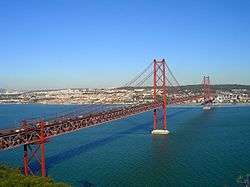
The construction of the 25 de Abril Bridge began on 5 November 1962. Forty-five months later, the bridge was inaugurated on 6 August 1966 as the Salazar Bridge, after the Estado Novo regime's leader António de Oliveira Salazar. Soon after the Carnation Revolution in 1974, the bridge was renamed the 25 de Abril Bridge, the day the revolution had occurred. A symbol of those times was captured on film, with citizens removing the big brass "Salazar" sign from one of the main pillars of the bridge and painting a provisional "25 de Abril" in its place.
In Portugal, many avenues, squares, and streets are named after the day of the revolution, vinte e cinco de Abril.
The Portuguese Mint chose the 40th anniversary of the Carnation Revolution for its 2014 2 euro commemorative coin.[41]
Evaluations of the revolution's outcomes
After an early period of turmoil, Portugal emerged as a democratic country. It took several years to create a strong democratic government due to the radical leftist inclination of some of the leading revolutionaries, and during this period Portugal divested itself of almost all of its colonies and underwent severe economic turmoil, as the old regime had shaped the Portuguese economy with such a stranglehold that it took some time to nationalize and reprivatize businesses. For the Portuguese and their former colonies, this was a very difficult period, but many felt that the short-term effects of the Carnation Revolution were well worth the trouble when civil rights and political freedoms were achieved. The Portuguese celebrate Freedom Day on 25 April every year, and the day is a national holiday in Portugal.
Most moderate or non-aligned political sectors of the population consider that the core objectives of the revolution were achieved, although there are differing views held by supporters of the former regime and also by supporters of the revolution who felt it did not go far enough.
By refusing to grant independence to its colonies in Africa, the Portuguese ruling regime of Estado Novo was criticized by most of the international community, and its leaders Salazar and Caetano were accused of being deaf to the so-called "winds of change". After the Carnation Revolution in 1974 and the fall of the incumbent Portuguese authoritarian regime, almost all the Portuguese-ruled territories outside Europe became independent. Several historians have described the stubbornness of the regime as a lack of sensibility to the "winds of change". For the regime, those overseas possessions were a matter of national interest.
In 2011 during the Portuguese financial crisis when the country was under the right-wing government of Pedro Passos Coelho and had to request international financial assistance, Otelo Saraiva de Carvalho stated that he wouldn't have made the revolution if he had known what the country would become after it.[42] He also stated that the country would need a man as honest as Salazar to deal with the crisis, but from a non-fascist perspective.[43]. But later he reverted his position and said that the Carnation Revolution was worth it and that he was proud of his role in it.[44]
Films
- Setúbal, ville rouge. France/Portugal 1975 – documentary, b/w and color, 16 mm, 93 min, by Daniel Edinger – In October 1975, in Setubal, the neighborhood committees, the factory committees, the soldiers committees and the peasant cooperatives join to organize a central committee.
- Cravos de Abril (1976) – historical documentary, b/w and color 16 mm, 28 min, by Ricardo Costa, portraying the revolutionary events from 24 April to 1 May 1974, illustrated by the French cartoonist Siné. Find information in French.
- Scenes from the Class Struggle in Portugal – U.S./Portugal 1977, 16 mm, b/w and color, 85 min, by Robert Kramer and Philip Spinelli as producer.
- Capitães de Abril (April Captains), a 2000 fiction feature film by Maria de Medeiros, depicts the Carnation Revolution. The BBC made a two-part series of television programmes from the film for the UK's Open University entitled "A New Sun is Born". The first episode details the coup and the second one the transition to democracy.[45]
- Longwave (Les Grandes Ondes (à l'ouest)), a 2013 screwball comedy about Swiss radio reporters assigned to Portugal in 1974.[46][47]
See also
References
- ↑ "1974: Rebels seize control of Portugal", On This Day, 25 April, BBC, 25 April 1974, retrieved 2 January 2010
- ↑ Association, Peter Booker, Algarve History. "Why April 25th is a holiday - the Carnation Revolution and the events of 1974". Retrieved 2017-12-29.
- ↑ Lewis, Paul H. (2002). Latin Fascist Elites: The Mussolini, Franco, and Salazar Regimes. Praeger. p. 133. ISBN 0-275-97880-X.
- ↑ Birmingham, David (1996), A Concise History of Portugal, JHU Press, p. 184, ISBN 978-0-8018-5158-2,
Almost immediately, massive crowds filled the streets, supporting the junior officers, crowds that put carnations in the soldiers' guns, thus helping legitimize and make irreversible the "carnation revolution".
- ↑ (in Portuguese) Cronologia: Movimento dos capitães, Centro de Documentação 25 de Abril, University of Coimbra
- ↑ (in Portuguese) Arquivo Electrónico: Otelo Saraiva de Carvalho, Centro de Documentação 25 de Abril, University of Coimbra
- 1 2 (in Portuguese) A Guerra Colonial na Guine/Bissau (07 de 07) on YouTube, Otelo Saraiva de Carvalho on the Decree Law, RTP 2 television, youtube.com.
- ↑ Manuel Amaro Bernardo, Guerra, Paz e Fuzilamentos dos Guerrilheiros
- ↑ Flight from Angola, The Economist (16 August 1975).
- ↑ Dismantling the Portuguese Empire, Time Magazine (Monday, 7 July 1975).
- ↑ Cheers, Carnations and Problems, Time Magazine (May. 13, 1974)
- ↑ Stewart Lloyd-Jones, ISCTE (Lisbon), Portugal's history since 1974, "The Portuguese Communist Party (PCP–Partido Comunista Português), which had courted and infiltrated the MFA from the very first days of the revolution, decided that the time was now right for it to seize the initiative. Much of the radical fervour that was unleashed following Spínola's coup attempt was encouraged by the PCP as part of their own agenda to infiltrate the MFA and steer the revolution in their direction.", Centro de Documentação 25 de Abril, University of Coimbra
- 1 2 "Adrian Hastings". The Daily Telegraph. London. 26 June 2001.
- ↑ Gomes, Carlos de Matos, Afonso, Aniceto. Oa anos da Guerra Colonial – Wiriyamu, De Moçambique para o mundo. Lisboa, 2010
- ↑ Arslan Humbarachi & Nicole Muchnik, Portugal's African Wars, N.Y., 1974.
- ↑ Cabrita, Felícia (2008). Massacres em África. A Esfera dos Livros, Lisbon. pp. 243–282. ISBN 978-989-626-089-7.
- ↑ Westfall, William C., Jr., Major, United States Marine Corps, Mozambique-Insurgency Against Portugal, 1963–1975, 1984. Retrieved on 10 March 2007
- ↑ "MOZAMBIQUE: Mystery Massacre". Time. 30 July 1973.
- ↑ "PORTUGUESE PRIME MINISTER (VISIT) (Hansard, 10 July 1973)". hansard.millbanksystems.com. Retrieved 2017-07-21.
- ↑ A direita radical na Universidade de Coimbra (1945–1974) Archived 3 March 2009 at the Wayback Machine., MARCHI, Riccardo. A direita radical na Universidade de Coimbra (1945–1974). Anál. Social, July 2008, nº 188, pp. 551–76. ISSN 0003-2573.
- 1 2 (in Portuguese) Movimento das Forças Armadas (MFA). In Infopédia [Em linha]. Porto: Porto Editora, 2003–2009. [Consult. 2009-01-07]. Disponível na www: URL: http://www.infopedia.pt/$movimento-das-forcas-armadas-(mfa)%5Bpermanent+dead+link%5D.
- ↑ Movimento das Forças Armadas (1974–1975), Projecto CRiPE – Centro de Estudos em Relações Internacionais, Ciência Política e Estratégia. © José Adelino Maltez. Cópias autorizadas, desde que indicada a origem. Última revisão em: 2 October 2008
- ↑ "The Carnation Revolution – A Peaceful Coup in Portugal - Association for Diplomatic Studies and Training". Association for Diplomatic Studies and Training. 2015-04-13. Retrieved 2018-10-02.
- ↑ (in Portuguese) ENTREVISTA COM ALPOIM CALVÃO, Centro de Documentação 25 de Abril, University of Coimbra
- ↑ Benetech Human Rights Data Analysis Group (9 February 2006). "The Profile of Human Rights Violations in Timor-Leste, 1974–1999". A Report to the Commission on Reception, Truth and Reconciliation of Timor-Leste. Human Rights Data Analysis Group (HRDAG). Archived from the original on 22 February 2012.
- ↑ Haggett, Peter (July 2001), Encyclopedia of World Geography, Marshall Cavendish, ISBN 978-0-7614-7289-6
- ↑ Fundação da SEDES — As primeiras motivações (in Portuguese), SEDES,
Nos anos 60 e até 1973 teve lugar, provavelmente, o mais rápido período de crescimento económico da nossa História, traduzido na industrialização, na expansão do turismo, no comércio com a EFTA, no desenvolvimento dos sectores financeiros, investimento estrangeiro e grandes projectos de infra-estruturas. Em consequência, os indicadores de rendimentos e consumo acompanham essa evolução, reforçados ainda pelas remessas de emigrantes.
- ↑ Sequeira, Tiago Neves, Crescrimento Económico no Pós-Guerra: os casos de Espanha, Portugal e Irlanda (PDF) (in Portuguese), University of Beira Interior
- ↑ Leite, Joaquim da Costa, Instituições, Gestão e Crescimento Económico: Portugal, 1950–73 (in Portuguese), Aveiro University
- ↑ (in Portuguese) A verdade sobre o Fundo do Ultramar Archived 11 May 2013 at the Wayback Machine., Diário de Notícias (29 November 2012)
- ↑ Movimento das Forças Armadas (1974–1975), Projecto CRiPE- Centro de Estudos em Relações Internacionais, Ciência Política e Estratégia. © José Adelino Maltez. Cópias autorizadas, desde que indicada a origem. Última revisão em: 2 October 2008
- ↑ (in Portuguese) Movimento das Forças Armadas (MFA). In Infopédia [Em linha]. Porto: Porto Editora, 2003–2009. [Consult. 2009-01-07]. Disponível na www: <URL: http://www.infopedia.pt/$movimento-das-forcas-armadas-(mfa)>.
- ↑ João Bravo da Matta, A Guerra do Ultramar, O Diabo, 14 October 2008, pp.22
- ↑ "Portugal", Country Studies, U.S. Library of Congress,
In the mid-1980s, agricultural productivity was half that of the levels in Greece and Spain and a quarter of the EC average. The land tenure system was polarized between two extremes: small and fragmented family farms in the north and large collective farms in the south that proved incapable of modernizing. The decollectivization of agriculture, which began in modest form in the late 1970s and accelerated in the late 1980s, promised to increase the efficiency of human and land resources in the south during the 1990s.
- ↑ "Portugal Agriculture", The Encyclopedia of the Nations
- ↑ Linz, Juan José (1996), Problems of Democratic Transition and Consolidation, JHU Press, ISBN 978-0-8018-5158-2
- ↑ "Economic Growth and Change", Country Studies, U.S. Library of Congress
- ↑ (in Portuguese) Grande investigação DN Conheça o verdadeiro peso do Estado Archived 8 January 2011 at the Wayback Machine., Diário de Notícias (7 January 2011)
- ↑ REGISTRATION OF RELIGIOUS COMMUNITIES IN EUROPEAN COUNTRIES
- ↑ Almeida, Manuel de Jesus. Watchtower, 7 January 1999. – P.23-7
- ↑ "Commemorative coins". European Commission - European Commission. Archived from the original on 19 October 2017. Retrieved 21 July 2017.
- ↑ (in Portuguese) «Se soubesse como o País ia ficar, não fazia a revolução», Destak.pt (April 13, 2011)
- ↑ (in Portuguese) <<Otelo: precisamos de um homem honesto como Salazar>>, in Diário de Notícias (April 21, 2011)
- ↑ "2017 interview (in Portuguese)". YouTube. Retrieved 26 January 2018.
- ↑ A New Sun Is Born Part 1 The Coup (1997)
- ↑ Boyd van Hoeij (22 August 2013). "Longwave (Les Grandes Ondes (a l'Ouest)): Locarno Review". The Hollywood Reporter. Retrieved 28 March 2014.
- ↑ "Les grandes ondes (à l'ouest) (2013)". IMDb. Retrieved 28 March 2014.
Further reading
- Barker, Collin. Revolutionary Rehearsals. 266 Pages. Haymarket Books. First Edition, 1 December 2002. ISBN 1-931859-02-7.
- Phil Mailer, Portugal: The Impossible Revolution? (All sixteen chapters and the introduction by Maurice Brinton)
- Ferreira, Hugo Gil, and Marshall, Michael William. "Portugal's Revolution: 10 years on". Cambridge University Press, 303 pages, 1986. ISBN 0-521-32204-9
- Green, Gil. Portugal's Revolution. 99 pages. International Publishers. First Edition, 1976. ISBN 0-7178-0461-5.
- Mailer, Phil. Portugal: The Impossible Revolution? PM Press. 2nd ed. 2012. ISBN 978-1-60486-336-9
- Maxwell, Kenneth, 'Portugal: “The Revolution of the Carnations”, 1974–75’, in Adam Roberts and Timothy Garton Ash (eds.), Civil Resistance and Power Politics: The Experience of Non-violent Action from Gandhi to the Present. Oxford & New York: Oxford University Press, 2009, pp. 144–61. ISBN 978-0-19-955201-6.
- Wise, Audrey. Eyewitness in Revolutionary Portugal. Bertrand Russell Peace Foundation for Spokesman Books, 72 pages, 1975
- George Wright, The Destruction of a Nation: United States Policy Towards Angola Since 1945, ISBN 0-7453-1029-X
External links
| Wikiquote has quotations related to: Carnation Revolution |
| Wikimedia Commons has media related to Revolução dos Cravos. |
- Accounts of the Carnation Revolution by U.S. diplomats Association for Diplomatic Studies and Training (ADST)
